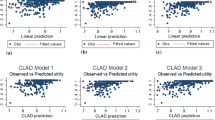Abstract
We propose to develop a methodology for evaluating clinical interventions for epilepsy in terms of their effects on disease-related outcomes, social cost and quality of life, while incorporating patient preference. The technique represents an extension of the ‘quality-adjusted time without symptoms and toxicities’ (Q-TWiST) method, which has been previously used to evaluate treatments for cancer and AIDS with respect to their costs in terms of toxicities, and benefits in terms of improved progression-free and overall survival. The extensions we propose to develop allow additional dimensions of quality of life relevant to epilepsy to be included in the analysis. We demonstrate a possible application of the proposed Q-TWiST method with a hypothetical example comparing surgeryvs antiepileptic medication management alone for seizure control. The trade-offs between these alternative treatments are highlighted, along with patient importance weightings regarding various dimensions of quality of life. We describe further research needed to develop the methodology fully and comment on its potential usefulness.
Similar content being viewed by others
References
Frank A.At the Will of the Body. Boston: Houghton Mifflin Company, 1991: 118.
Engel J, Van Ness P, Rasmussen T, Ojemann L. Outcome with respect to epileptic seizures. In: Engel J (ed.)Surgical Treatment of the Epilepsies, 2nd Edn. New York: Raven Press, 1993: 609–622.
Hermann BP, Wyler AR, Somes G. Preoperative psychological adjustment and surgical outcome are determinants of psychosocial status after anterior temporal lobectomy.J Neurol Neurosurg Psychiatry 1992;55: 491–496.
Schwartz CE, Cole BF, Gelber, RD. Measuring patient-centered outcomes in neurologic disease: extending the Q-TWiST methodology.Qual Life Res 1994;3: 62.
Gelber RD, Goldhirsch A. A new endpoint for the assessment of adjuvant therapy in postmenopausal women with operable breast cancer.J Clin Oncol 1986;4: 1772–1779.
Goldhirsch A, Gelber RD, Simes J, Glasziou P, Coates AS; for the Ludwig Breast Cancer Study Group. Costs and benefits of adjuvant therapy in breast cancer: A quality-adjusted survival analysis.J Clin Oncol 1989;7 36–44.
Gelber RD, Lenderking WR, Cotton DJ, Cole BF, Fischl MA, Goldhirsch A, Testa MA; for the AIDS Clinical Trials Group. Quality-of-life evaluation in a clinical trial of ziduvudine therapy in patients with middly symptomatic HIV infection.Ann Intern Med 1992;116: 961–966.
Gelber RD, Cole BF, Goldhirsch A. Comparing treatments using quality-adjusted survival: The Q-TWiST method.Am stat, in press.
Cole BF, Gelber RD, Anderson KM. Parametric approaches to quality adjusted survival analysis.Biometrics 1994:in press.
Glasziou PP, Simes RJ, Gelber RD. Quality adjusted survival analysis.Stat Med 19909: 1259–1276.
Vickrey B, Hays R, Engel J Jr, Spritzer K, Rogers W, Rausch R, Graber J, Brook R. Outcome assessment for epilepsy surgery: The impact of measuring health-related quality of life.Ann Neurol, in press.
Cramer JA, Smith DB, Mattson RH, Delgado-Esculta AV; and the VA Epilepsy Cooperative Study #118 Group. A method of quantification for the evaluation of antiepileptic drug therapy.Neurology 1983;33 (Suppl 1): 26–37.
von Neumann J, Morgenstern O.The Theory of Games and Economic Behavior. New York: Wiley, 1953.
Torrance GW, Thomas WH, Sackett DL. A utility maximization model for evaluation of health care programs.Health Serv Res 1972;7: 118–133.
Torrance GW, Boyle MH, Horwood SP. Application of multi-attribute utility theory to measure social preferences for health states.Oper Res 1982;30: 1043–109.
Reynolds EH. Early treatment and prognosis of epilepsy.Epilepsia 1987;28: 97–106.
National Institutes of Health Consensus Conference. Surgery for epilepsy,JAMA 1990;264: 729.
LaPlante E.Seized. New York: Harper Collins, 1993.
Lechtenberg R.Seizure Recognition and Treatment. New York: Churchill Livingston, 1990: 190.
Cahan LD, Sutherling W, McCullough MA, Rausch R, Engel J, Crandall PH. Review of the 20-year UCLA experience with surgery for epilepsy.Cleveland Clin Q 1984;51:313–318.
Walczak TS, Radtke RA, McNamara JO, et al. Anterior temporal lobectomy for complex partial seizures: Evaluation, results, and long-term follow-up in 100 cases.Neurology 1990;40: 413.
Schoenbaum SC. Toward fewer procedures and better outcomes.JAMA 1993;269: 794–796.
Augustine EA, Novelly RA, Mattson RH, Glaser GH, Williamson PD, Spencer DD, Spencer SS. Occupational adjustment following neurosurgical treatment of epilepsy.Ann Neurol 1984;15: 68–72.
Milner B. Disorders of learning and memory after temporal lobe lesions in man.Clin Neurosurg 1972;19: 421–446.
Krumholz A, Fisher RS, Lesser RP, Hauser WA. Driving and epilepsy. A review and reappraisal.JAMA 1991;265: 622–626.
Berkman LF, Syme SL. Social networks, host resistance, and mortality: A nine-year follow-up study of Alameda County residents.Am J Epidemiol 1979;109: 186–204.
Collings JA. Epilepsy and well-being.Soc Sci Med 1990;31: 165–170.
Mossey JM, Mutran E, Knott K, Craik R. Determinants of recovery 12 months after hip fracture: the importance of psychosocial factors.Am J Public Health 1989;79: 279–86.
Kaplan RM, Anderson JP. The general health policy model: An integrated approach. In: Spilker B (ed.),Quality of Life Assessments in Clinical Trials. New York: Raven Press, 1990.
Author information
Authors and Affiliations
Rights and permissions
About this article
Cite this article
Schwartz, C.E., Cole, B.F., Vickrey, B.G. et al. The Q-TWiST approach to assessing health-related quality of life in epilepsy. Qual Life Res 4, 135–141 (1995). https://doi.org/10.1007/BF01833607
Issue Date:
DOI: https://doi.org/10.1007/BF01833607




